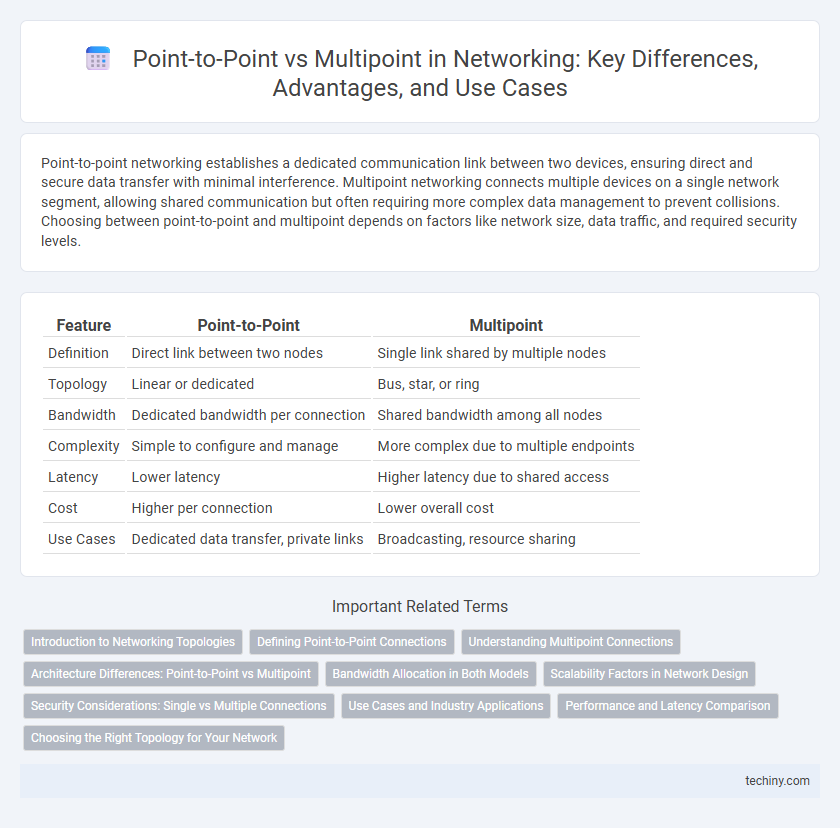Point-to-point networking establishes a dedicated communication link between two devices, ensuring direct and secure data transfer with minimal interference. Multipoint networking connects multiple devices on a single network segment, allowing shared communication but often requiring more complex data management to prevent collisions. Choosing between point-to-point and multipoint depends on factors like network size, data traffic, and required security levels.
Table of Comparison
| Feature | Point-to-Point | Multipoint |
|---|---|---|
| Definition | Direct link between two nodes | Single link shared by multiple nodes |
| Topology | Linear or dedicated | Bus, star, or ring |
| Bandwidth | Dedicated bandwidth per connection | Shared bandwidth among all nodes |
| Complexity | Simple to configure and manage | More complex due to multiple endpoints |
| Latency | Lower latency | Higher latency due to shared access |
| Cost | Higher per connection | Lower overall cost |
| Use Cases | Dedicated data transfer, private links | Broadcasting, resource sharing |
Introduction to Networking Topologies
Point-to-point topology establishes a direct, dedicated communication link between two nodes, offering high efficiency and simple data transfer suitable for small networks. Multipoint topology connects multiple nodes over a single communication channel, optimizing resource use and reducing infrastructure costs in larger, complex networks. Choosing the appropriate topology impacts network performance, scalability, and fault tolerance in diverse networking environments.
Defining Point-to-Point Connections
Point-to-point connections establish a direct communication link between two specific network devices, providing dedicated bandwidth and reducing latency. These connections are commonly used in leased lines, fiber optic links, and wireless bridges to ensure secure and reliable data transfer. By limiting traffic to just the two endpoints, point-to-point connections optimize performance and simplify network management compared to multipoint setups.
Understanding Multipoint Connections
Multipoint connections enable multiple devices to share a single communication channel, increasing network efficiency by reducing the number of required physical links compared to point-to-point connections. This setup is common in local area networks (LANs) and wireless networks, where bandwidth management and collision detection protocols like CSMA/CD or CSMA/CA ensure data integrity. Multipoint configurations support scalability and resource optimization but can introduce latency and complexity in managing simultaneous transmissions.
Architecture Differences: Point-to-Point vs Multipoint
Point-to-point network architecture involves a direct connection between two nodes, ensuring dedicated communication channels that optimize speed and security. In contrast, multipoint architecture connects multiple devices on a single shared medium, allowing efficient resource utilization but introducing potential contention and complexity in data management. The fundamental architectural difference lies in exclusive versus shared links, impacting performance, scalability, and network design choices.
Bandwidth Allocation in Both Models
Point-to-point networking allocates dedicated bandwidth between two devices, ensuring consistent and predictable data transfer rates without contention. In contrast, multipoint networks share bandwidth among multiple nodes, often resulting in variable throughput due to simultaneous access demands and potential bottlenecks. Efficient bandwidth allocation in multipoint models requires collision management and dynamic resource distribution to optimize overall network performance.
Scalability Factors in Network Design
Point-to-point network designs offer direct connections between devices, providing high security and dedicated bandwidth but limiting scalability due to increased complexity and resource requirements as nodes grow. Multipoint networks enable multiple devices to share a single communication channel, enhancing scalability by reducing the number of connections needed but potentially introducing bandwidth contention and latency issues. Effective network design balances scalability factors by choosing point-to-point for smaller, performance-critical systems and multipoint for larger, flexible deployments requiring efficient resource utilization.
Security Considerations: Single vs Multiple Connections
Point-to-point connections offer enhanced security by limiting access to a single dedicated link, reducing the risk of unauthorized interception. Multipoint connections share a communication channel among multiple devices, increasing vulnerability to eavesdropping and potential data breaches if encryption is not robust. Implementing strong authentication and encryption protocols is critical in multipoint configurations to safeguard sensitive information across multiple access points.
Use Cases and Industry Applications
Point-to-point networking is ideal for dedicated, high-bandwidth connections such as leased lines in telecommunications and private enterprise WAN links, ensuring secure and reliable communication between two specific locations. Multipoint networking excels in environments requiring shared resources or connectivity among multiple devices, common in local area networks (LANs), broadcast networks, and IoT implementations within smart cities and industrial automation. Industries like telecommunications, manufacturing, and smart infrastructure leverage point-to-point for critical data transfer and multipoint for scalable, flexible connectivity.
Performance and Latency Comparison
Point-to-point connections typically offer lower latency and higher performance as they establish a direct link between two devices, minimizing congestion and data packet collisions. Multipoint networks share a single communication channel among multiple devices, often resulting in increased latency and reduced throughput due to the need for bandwidth allocation and collision management. Network scalability in multipoint setups can cause variable delay, whereas point-to-point maintains consistent low latency ideal for time-sensitive applications.
Choosing the Right Topology for Your Network
Selecting the right network topology depends on the specific requirements of your infrastructure, such as scalability, cost, and performance. Point-to-point topologies provide direct connections between two devices, offering low latency and high security, ideal for dedicated links in small networks or backbone connections. Multipoint topologies enable multiple devices to share a single communication channel, which optimizes resource use and simplifies cabling but may introduce latency and collision risks in larger or high-traffic networks.
point-to-point vs multipoint Infographic

 techiny.com
techiny.com